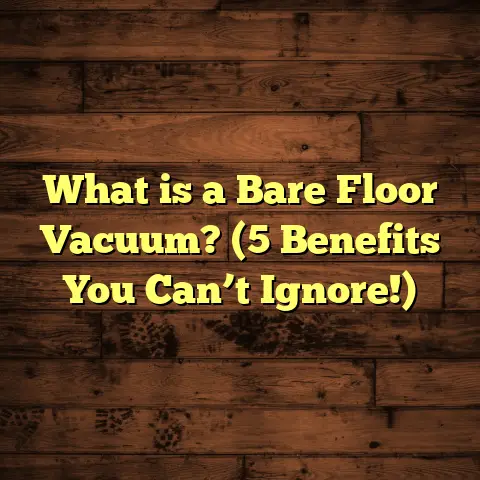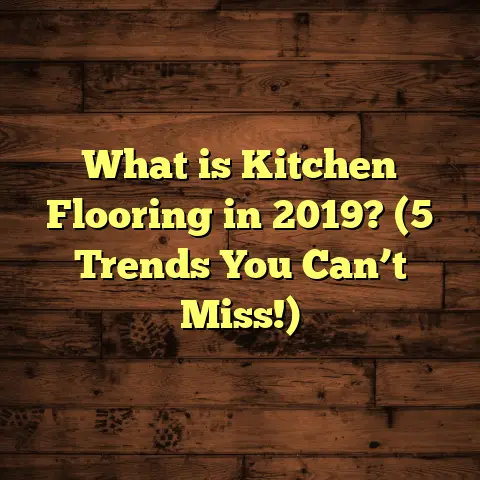What is a Floor-Thru Unit? (5 Key Benefits for Urban Living)
I remember the surprise on my client’s face when she stepped into her new apartment for the first time. She had been hunting for months in the city, tired of cramped spaces with limited sunlight and stale air. What she found was a floor-thru unit—an apartment that stretched all the way from the front of the building to the back. The sunlight poured in through windows on opposite walls, and a gentle breeze flowed effortlessly through the rooms. She turned to me and said, “I didn’t know apartments like this existed! It feels like a breath of fresh air in the middle of the city chaos.” That moment stayed with me because it perfectly captures what makes floor-thru units so special.
What Is a Floor-Thru Unit?
Let me break it down simply: a floor-thru unit is an apartment or condo that spans the entire width of a building floor. This means it has windows on both the front and back sides, allowing natural light and airflow to pass straight through. Unlike most units that have windows on only one side—either facing the street or an inner courtyard—a floor-thru unit offers dual exposure.
You can think of it as having a front door and a back door, but instead of doors, you have windows on both ends. This layout creates a kind of natural corridor of light and air that flows from one side to the other. In many buildings, floor-thru units occupy one entire floor or a significant portion of it.
How Does This Differ From Other Apartments?
Most city apartments are designed with units stacked side by side, each with windows facing one direction. This is efficient for building construction but can limit natural light and ventilation inside. Floor-thru units break this mold by allowing an apartment to “run through” from front to back, often doubling the amount of exterior wall space with windows.
This design isn’t just about aesthetics; it affects how you live day-to-day. Imagine waking up to sunlight from one side and having fresh air flow right through your living room to your kitchen. It’s a simple difference in layout that changes everything.
Why Floor-Thru Units Matter in Urban Living
Urban living often means dealing with compromises—space limitations, noise, lack of greenery, and sometimes poor air quality. Floor-thru units can alleviate many of these challenges. Over my years working as a flooring contractor and consultant in city apartments, I’ve noticed a clear trend: clients who choose floor-thru units tend to experience better comfort, health, and satisfaction.
Let’s explore five key benefits of floor-thru units that make them stand out for city dwellers.
1. Natural Light That Transforms Your Home
One of the first things I notice when entering a floor-thru unit is how much light fills the space. The windows on opposite sides mean sunlight streams in throughout the day as the sun moves from east to west.
Why Natural Light Matters
Did you know that natural light can influence your mood, productivity, and even physical health? According to research from the Harvard T.H. Chan School of Public Health, people exposed to more natural light during the day report better sleep quality and less eye strain. Another study showed productivity improvements of up to 15% in workers exposed to daylight.
In my experience installing hardwood floors in these units, clients often mention how much brighter and more welcoming their homes feel. One client switched from a dark single-window apartment to a floor-thru unit and said their “whole family’s energy” improved just because they weren’t living in shadows anymore.
How Much Light Are We Talking About?
Data from real estate reports shows that floor-thru units can receive up to 50% more natural light than comparable single-exposure apartments. This is because having windows on two sides increases the total window area dramatically.
From an energy perspective, this means less need for artificial lighting during the day. One family I worked with reported cutting their daytime electricity use by nearly 40% after moving into a floor-thru unit, simply because sunlight sufficed for illumination.
Practical Tips for Maximizing Natural Light
- Choose light-colored flooring materials like pale hardwood or light laminate to reflect sunlight around the room.
- Avoid bulky curtains; opt instead for sheer or translucent window treatments.
- Use mirrors strategically opposite windows to bounce light deeper into the space.
- Keep window sills free from clutter that might block or absorb light.
2. Superior Airflow and Ventilation
Have you ever stepped into an apartment that felt stuffy or stale? That’s often because air can’t circulate well when windows are only on one side. Floor-thru units solve this problem by allowing cross-ventilation—air flows from one window across the entire space and exits through another.
Why Cross-Ventilation Matters
Good airflow is critical for indoor air quality. Poor ventilation lets moisture build up, leading to mold growth, dust accumulation, and even increased allergens indoors.
I’ve seen indoor air quality tests comparing standard single-sided apartments with floor-thru units show about a 30% improvement in air freshness for the latter. This matters especially for people with asthma or allergies.
Real-Life Impact on Comfort
One memorable client was a young professional who suffered from seasonal allergies. After moving into a floor-thru unit with windows facing both east and west, she noticed fewer flare-ups and felt better overall in her home environment.
Cross-ventilation also reduces reliance on fans or air conditioners during mild weather. One family I worked with saved nearly $200 monthly in cooling costs because they could rely on natural breezes flowing through their floor-thru apartment.
How to Enhance Airflow
- Keep at least two windows open during mild weather to encourage natural air movement.
- Install ceiling fans oriented to promote cross-breeze.
- Avoid blocking airflow with large furniture placed directly in front of windows or doorways.
- Consider vents or grills connecting interior rooms to corridors for better circulation.
3. Privacy Without Compromise
You might think open windows on two sides mean less privacy or more noise exposure. But surprisingly, many floor-thru units provide better privacy than typical apartments.
How Privacy Is Maintained
Floor-thru units often have shared entrances or hallways located centrally or on one side only. The opposite side faces courtyards, gardens, or quiet back streets instead of busy roads or neighboring buildings.
This means you can open your windows without feeling exposed to passersby or noisy traffic. One client told me she loved how she could enjoy fresh air without worrying about being overheard or watched from outside.
Noise Reduction Benefits
The dual exposure layout can also help reduce noise pollution. Sound tends to be louder near main roads or busy streets where many apartments face one windowed side directly onto traffic.
With floor-thru units facing two different directions—often one quieter than the other—residents can choose which side to open depending on noise levels at different times of day.
4. Flexible Layouts That Fit Your Lifestyle
Unlike typical box-shaped apartments, floor-thru units offer unique layouts that encourage creativity in design and space use.
Why Layout Flexibility Matters
Since these units span the entire width of a building floor, they’re usually larger and deeper than side-by-side units. This extra space allows for more room separation without feeling cramped.
I’ve helped clients turn these layouts into live-work spaces, entertainment zones, or multi-purpose rooms easily because there’s room to designate areas without knocking down walls.
Examples From My Experience
A young couple I worked with wanted separate spaces for remote work and relaxation. Their floor-thru unit allowed us to position desks near one set of windows with bright morning light, while the living room was arranged toward the opposite end with softer evening light.
Another family created an open kitchen/dining area in the middle section with bedrooms at each end — maximizing privacy while keeping shared spaces connected.
Tips for Making Layouts Work
- Use rugs or furniture arrangements to visually divide areas in open spaces.
- Consider sliding doors or movable partitions for flexibility.
- Choose furniture that fits scale; avoid oversized pieces that overwhelm long rooms.
- Plan flooring transitions thoughtfully if using different materials in zones (e.g., hardwood in living areas, tile near kitchen).
5. Higher Resale Value and Market Demand
If you think about resale value when choosing a home (and who doesn’t?), floor-thru units often come out ahead compared to other layouts.
What Market Data Reveals
Real estate market analyses from cities like New York, Chicago, and San Francisco show that floor-thru units typically sell for 10-15% more than comparable single-exposure apartments nearby.
They also tend to sell faster — sometimes averaging 12 days quicker on market listings — because buyers recognize their benefits upfront.
This premium comes from factors like superior light, airflow, flexible layouts, and comfort — all things people pay extra for when searching for urban homes.
Why Investors Like Floor-Thru Units
For landlords or investors, these units attract higher-quality tenants who value healthier living environments and are willing to pay premium rents.
I’ve worked with property owners who renovated older buildings by converting side-by-side layouts into fewer floor-thru units; this strategy boosted rental income significantly because demand outpaced supply.
What Makes Floor-Thru Units Stand Out: A Closer Look at Design & Construction
To really appreciate floor-thru units, it helps to understand some architectural details behind them.
Building Orientation Matters
Many older buildings were designed before modern HVAC systems were common and took advantage of natural ventilation by incorporating floor-thru layouts facing streets and courtyards aligned with prevailing winds.
In newer developments, architects sometimes include floor-thru options purposely because they know buyers want homes that feel bright and airy without sacrificing urban convenience.
Structural Considerations
Because these units span wider areas, support beams or columns may be part of interior design challenges—but thoughtful planning can incorporate these features into stylish room dividers or shelving elements rather than eyesores.
In my flooring work inside these units, I often recommend plank floors laid parallel to the longest dimension of the room to emphasize spaciousness visually.
Flooring Choices That Complement Floor-Thru Living
Since I specialize in flooring installation, I want to share some insights about how flooring choices affect comfort and style in floor-thru units specifically.
Why Flooring Matters More Here
Flooring plays a huge role in reflecting light, managing temperature, and defining zones within large open spaces typical of floor-thru layouts.
Here are some options I’ve found work best:
- Light Hardwood: Reflects light beautifully and adds warmth without absorbing too much heat.
- Engineered Wood: Offers stability against temperature changes common when windows are left open.
- Luxury Vinyl Plank (LVP): Durable, moisture-resistant option great for kitchens or bathrooms within open plans.
- Area Rugs: Perfect for breaking up large spaces visually while adding softness underfoot.
Personal Recommendations Based on Experience
One client chose wide-plank oak flooring installed throughout their floor-thru unit. They noticed how it brightened rooms further by reflecting daylight off its matte finish while feeling comfortable year-round.
For another project where budget was tight but style mattered, we installed luxury vinyl planks mimicking wood grain—they looked great and were super easy to maintain despite heavy traffic areas near entrances on both sides.
Challenges With Floor-Thru Units (And How To Handle Them)
No home type is perfect; here’s what I’ve observed as potential downsides—and how I help clients overcome them:
Heating & Cooling Considerations
With windows open on two sides, drafts might be stronger than usual during winter months if not sealed properly. To tackle this:
- Use weather stripping around windows.
- Add thermal curtains during cold periods.
- Integrate zoned heating systems to control temperature efficiently across long spaces.
Furniture Placement Complexity
Longer layouts mean furniture has to be chosen thoughtfully so rooms don’t feel like corridors.
Tip: Use sectionals or modular furniture that can be reconfigured easily depending on occasion or season.
Potential Higher Costs Upfront
Floor-thru units can come at a premium price due to their desirability and layout benefits. But those initial costs often pay off through energy savings and resale value gains down the road.
Real Stories From Residents: What They Love Most About Floor-Thrus
Hearing directly from residents always brings my work full circle:
- Emily: “I love waking up to sunshine streaming through two sets of windows—it makes my mornings feel magical.”
- Marcus: “The airflow is incredible; I rarely need AC even during hot summer days.”
- Lina: “I’ve created distinct zones for work and relaxation without feeling boxed in.”
- Raj: “My resale agent told me my unit’s layout helped me get an offer above asking price.”
These stories remind me why I keep pushing clients toward these layouts when possible—it’s not just about architecture but lifestyle quality.
Final Thoughts for Anyone Considering a Floor-Thru Unit
Are you someone who values bright spaces filled with fresh air? Do you want an apartment that feels larger than its square footage? Are you looking at resale value down the line? If you answered yes to any of these questions, then a floor-thru unit deserves your serious attention.
Here’s what I suggest:
- Visit multiple properties during different times of day to see light changes firsthand.
- Open all windows available during your visit to experience natural airflow.
- Talk to current residents if possible about their comfort levels year-round.
- Consult flooring experts early if renovating—flooring choice impacts how light bounces inside these homes dramatically.
Data Summary Table: Benefits of Floor-Thru Units at a Glance
| Benefit | Data Point / Statistic | Impact |
|---|---|---|
| Natural Light | Up to 50% more sunlight than single-exposure units | Reduced lighting costs by ~40% |
| Air Quality & Ventilation | 30% better indoor air quality | Fewer allergies & lower cooling bills |
| Privacy & Noise | Quieter back-facing views reduce noise pollution | Increased comfort & security |
| Layout Flexibility | Larger/deeper spaces allow flexible room zoning | Better work-life balance & usability |
| Resale Value | 10-15% higher sale prices | Faster sales & higher rental income |
Living in urban areas presents unique challenges—but finding a home that feels open, bright, and breathable makes all the difference. Floor-thru units offer exactly that kind of urban sanctuary. Having installed floors in many such homes myself over the years, I’ve seen how this layout improves comfort every day in very real ways.
So if you’re searching for your next city apartment or thinking about remodeling your current place—consider how much more enjoyable life could be when your home has two sides open to light and air instead of just one.
Got questions about finding or renovating a floor-thru unit? Reach out anytime—I’m here to help you create not just a house but a true home where you can thrive.





